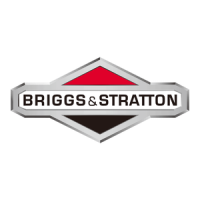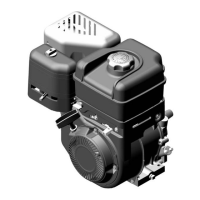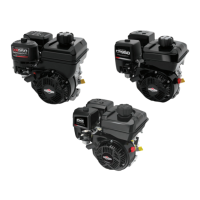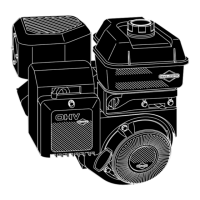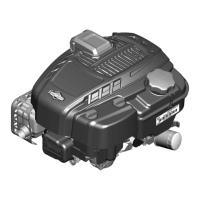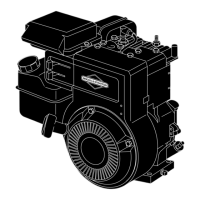Do you have a question about the Briggs & Stratton 140000 and is the answer not in the manual?
Provides safety alerts, signal words, and hazard symbols for safe operation and risk avoidance.
Details safety alert symbols, signal words (DANGER, WARNING, CAUTION), and hazard symbols for personal injury.
Explains safety information about hazards like fire, explosion, shock, toxic fumes, hot surface, and noise.
Identifies and locates engine features and controls like fuel tank, air cleaner, and throttle.
Explains symbols used for engine speed, stop, start, choke, and fuel shut-off functions.
Provides guidance on selecting the correct oil type and viscosity for optimal engine performance.
Instructions on how to check and add engine oil, ensuring the correct level for operation.
Explains the function of the low oil sensor and steps to take if the oil level is low.
Guidance on safely adding fuel to the engine's fuel tank, including precautions.
Instructions for starting engines equipped with automatic choke and no primer.
Instructions for starting engines with a manual choke system for cool temperature operation.
General warnings and recommendations for engine maintenance procedures.
Instructions for checking and servicing the spark plug, including gap and torque specifications.
Detailed steps for draining and changing the engine oil, including safety precautions.
Procedure for replacing the engine oil filter, including lubrication and tightening instructions.
Steps for cleaning and servicing foam air filter elements, including oiling instructions.
Instructions for cleaning and replacing paper air filters and pre-cleaners.
Guidance on replacing the fuel filter, including draining the fuel tank and disconnecting lines.
Details the limited warranty terms for Briggs & Stratton engines, including coverage and exclusions.
Outlines standard warranty terms for different engine series and usage types (consumer vs. commercial).
Lists parts covered under the emissions control warranty, including fuel, air, and ignition systems.
Specifies the warranty period for emissions control systems and owner responsibilities.
States that the exhaust emissions control system is warranted for two years against defects.
Details the owner's duties regarding maintenance, record-keeping, and presenting the engine for service.
Provides safety alerts, signal words, and hazard symbols for safe operation and risk avoidance.
Details safety alert symbols, signal words (DANGER, WARNING, CAUTION), and hazard symbols for personal injury.
Explains safety information about hazards like fire, explosion, shock, toxic fumes, hot surface, and noise.
Identifies and locates engine features and controls like fuel tank, air cleaner, and throttle.
Explains symbols used for engine speed, stop, start, choke, and fuel shut-off functions.
Provides guidance on selecting the correct oil type and viscosity for optimal engine performance.
Instructions on how to check and add engine oil, ensuring the correct level for operation.
Explains the function of the low oil sensor and steps to take if the oil level is low.
Guidance on safely adding fuel to the engine's fuel tank, including precautions.
Instructions for starting engines equipped with automatic choke and no primer.
Instructions for starting engines with a manual choke system for cool temperature operation.
General warnings and recommendations for engine maintenance procedures.
Instructions for checking and servicing the spark plug, including gap and torque specifications.
Detailed steps for draining and changing the engine oil, including safety precautions.
Procedure for replacing the engine oil filter, including lubrication and tightening instructions.
Steps for cleaning and servicing foam air filter elements, including oiling instructions.
Instructions for cleaning and replacing paper air filters and pre-cleaners.
Guidance on replacing the fuel filter, including draining the fuel tank and disconnecting lines.
Details the limited warranty terms for Briggs & Stratton engines, including coverage and exclusions.
Outlines standard warranty terms for different engine series and usage types (consumer vs. commercial).
Lists parts covered under the emissions control warranty, including fuel, air, and ignition systems.
Specifies the warranty period for emissions control systems and owner responsibilities.
States that the exhaust emissions control system is warranted for two years against defects.
Details the owner's duties regarding maintenance, record-keeping, and presenting the engine for service.
| Fuel Type | Gasoline |
|---|---|
| Starting System | Recoil |
| Ignition System | Magnetron electronic ignition |
| Engine Type | 4-Stroke, OHV, Single Cylinder |
| Oil Capacity | 0.6 L |
| Spark Plug Gap | 0.030 in (0.76 mm) |
| Recommended Oil | SAE 30 |
